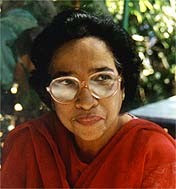Ruttenbai Ruttie Petit was sweet sixteen in 1916, when
Prince Charming rode into her life. He may not have arrived on a white charger.
But this dapper young man in his Saville Row suit and suede shoes cast a
magical spell on this beautiful, bright, vivacious teenager who was ready for
romance.
Mohammad Ali Jinnah a prominent lawyer from Bombay had
come to Darjeeling for a summer break, at the home of his famous client Sir
Dinshaw Petit, a Textile magnate. Jinnah was enchanted not only by Ruttie’s
beauty but also her intelligence. Her interests ranged from poetry to politics.
In spite of her tender age she could harangue on a wide range of subjects
including the Swaraj Movement which was involved in fighting for Indian
independence.
At the end of his stay in Darjeeling, Jinnah asked Sir
Dinshaw for Ruttie’s hand in marriage, but was refused. Ruttie was only sixteen
and belonged to the Parsi community. Jinnah was 41 years old and was a Muslim.
Ruttie was prohibited from seeing or speaking to this man. But when she got
back to Bombay, they continued their secret rendezvous for two years until she
attained majority.
In 1918, Ruttie converted to Islam and took the name of
Maryam. She was married to Jinnah on April 19, 1918, at his home ‘South Court’
on Malabar Hill, Bombay. Jinnah presented her with a ring which he had received
from the Raja of Muhamudabad, and a tidy sum of Rupees 125,000. Only very close
friends were invited to the wedding. Sir Dinshaw disowned his daughter and
never made contact with her again.
The first few years of married life were blissful. Jinnah
was smitten by her beauty and proud to show her off at various social
functions. Ruttie was equally at ease in western attire as well as her flowing
colourful saris. Her long tresses were decked with flowers and her head- bands
dazzling with precious stones were the envy of other society ladies. They made
a very handsome couple, as he too was always attired in custom made suits, a
pipe perpetually dangling from his lips. Sarojini Naidu called Ruttie ‘Flower
of Bombay.’ Dewan Chaman Lal who was smitten by her beauty said, “There is not
a woman in the whole world to hold a candle to her.”
Once when the couple went for dinner to Governor Wellington’s
house, Ruttie had worn a gown with a low neckline. The prudish Governor’s wife
asked the ADC to bring her a wrap. Jinnah was quick to take umbrage. He
retorted that if Ruttie needed one she would have asked for it. The couple made
a dignified exit from the Governor’s house without waiting for dinner.
Apart from beauty, Ruttie was witty and could hold her
own in any conversation. In May 1919, she made a very eloquent speech at the
All India Trade Conference. She was also active in different social spheres
such as welfare of children and animal rights. Her passion was for books, clothes
and pets.
The first six years of their married life were happy
ones. A daughter Dina was born to them. But successful men do not always make loving
husbands. They grew apart because Jinnah was so socially, politically and economically
powerful. He was a leading barrister in Bombay and was also the President of the
Bombay branch of Home Rule League. Ruttie felt his dour, humorless nature to be
stifling. His preoccupation with politics left very little time for his wife. She
felt isolated. But being of a strong nature she felt that if he could not give her
personal time, she wanted liberation. Jinnah was so engrossed in his political aspirations
that he had no time to bother about his wife who felt emotionally bereft.
In September 1922, Ruttie and her daughter went to London
for a few months. If she hoped that ‘absence would make the heart grow fonder,’
she was in for disappointment. Jinnah was totally preoccupied in campaigning for
the Bombay seat in the general elections. Ruttie withdrew into herself. She suffered
from insomnia, hallucinations and abdominal ailments. Her loneliness drove her to
the world of spirituality, mysticism, séances and clairvoyance. Jinnah was totally
oblivious of her failing health. In 1925, when he made a five-month tour of Europe
and North America, he took his family along. The trip sadly widened the gulf between
them.
In 1927, when the Muslim League shifted its head quarters
to Delhi, Ruttie stayed behind. She moved into a room at the Taj Hotel. Her deteriorating
health added to her sense of isolation. She had just one friend and confidante Kanji
Dwarakadas, to whom she poured out the story of her aching heart.
In 1928, Ruttie went to the Champs Elysee Clinic for treatment
of chronic colitis. While there, she poured out her heart in a love letter to Jinnah.
“I have loved you my darling as it is given to few men to be loved……Remember me
as the flower you plucked and not as the flower you trampled on.”
Ruttie Maryam Jinnah died on 15th September 1929,
at the age of 29 years. She was buried according to Muslim rites at the Khoja Cemetery
in Mazagaon, Bombay. Jinnah sat like a statue at the funeral, but broke down when
asked to throw a handful of mud on her grave. His friends said that this was the
only time they had seen this dour, cold politician show some humanness. He visited
her grave one last time in 1947, before leaving for Pakistan.
As Byron said, “Man’s love
is of Man’s life a thing apart. ‘Tis woman’s whole existence.”
One wonders if Jinnah ever
regretted the fact that he had never given his beloved wife the Gift of Time.








